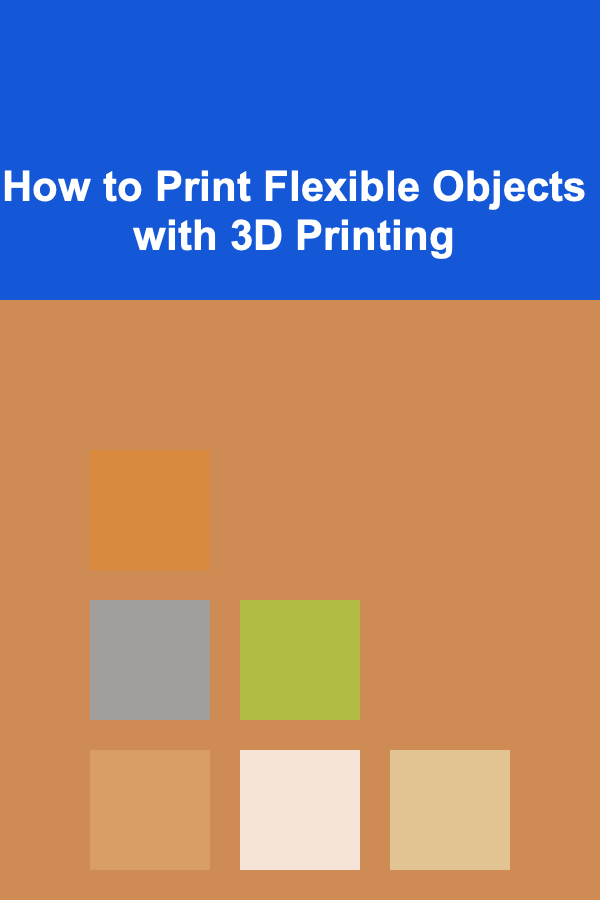
How to Print Flexible Objects with 3D Printing
ebook include PDF & Audio bundle (Micro Guide)
$12.99$9.99
Limited Time Offer! Order within the next:

3D printing, also known as additive manufacturing, has revolutionized the way we think about producing objects. From prototyping to production, this technology has made creating customized and complex designs more accessible. However, when it comes to printing flexible objects, 3D printing presents unique challenges and requires a deep understanding of materials, techniques, and design considerations. This article explores the intricacies of 3D printing flexible objects, including material choices, printing techniques, and the key considerations for achieving optimal results.
Understanding Flexible Materials
What Are Flexible Materials?
Flexible materials, often referred to as elastomers in the context of 3D printing, are substances that possess the ability to return to their original shape after being deformed. These materials are commonly used for producing objects that need to bend, stretch, or compress, such as gaskets, seals, phone cases, wearables, and even soft robotics.
In 3D printing, flexible materials can be classified based on their hardness, flexibility, and elasticity. The most common types of flexible filaments used in 3D printing include Thermoplastic Polyurethane (TPU), Thermoplastic Elastomer (TPE), and Silicone-based filaments. These materials offer different properties depending on the application, from high strength and durability to extreme flexibility.
Popular Flexible Filament Types
1. TPU (Thermoplastic Polyurethane)
TPU is one of the most widely used flexible 3D printing materials. It combines the benefits of both rubber and plastic, offering flexibility, durability, and resistance to wear and tear. TPU filaments are available in different hardness levels, measured on the Shore hardness scale, allowing for a wide range of applications.
Advantages of TPU:
- High elasticity and flexibility.
- Excellent abrasion and tear resistance.
- Good chemical resistance.
- Easy to print on most 3D printers when conditions are optimized.
Challenges of TPU:
- Printing with TPU requires a slower print speed and careful temperature control to avoid warping.
- TPU filaments can be difficult to handle due to their tendency to deform if not printed correctly.
2. TPE (Thermoplastic Elastomer)
TPE is another popular flexible filament used in 3D printing. TPE is softer than TPU, making it suitable for applications that require more bendability and softness, like soft-touch components and cushioning materials. It's commonly used for applications like footwear, toys, and ergonomic grips.
Advantages of TPE:
- High flexibility and softness.
- Strong resistance to impacts and abrasion.
- Can be used for more delicate applications like wearable items.
Challenges of TPE:
- Requires a high level of precision in printing.
- May experience adhesion issues with certain surfaces.
- Can be more difficult to print compared to other filaments due to its tendency to be "stringy."
3. Silicone-based Filaments
Silicone-based filaments are ideal for producing high-temperature resistant, soft, and flexible objects. These filaments offer superior flexibility and resilience, especially under extreme conditions like heat and moisture. Silicone-based filaments are more difficult to print and typically require specialized equipment.
Advantages of Silicone-based filaments:
- Extremely flexible, heat-resistant, and durable.
- Ideal for high-performance applications.
- Offers superior stability under various environmental conditions.
Challenges of Silicone-based filaments:
- Requires a specialized 3D printer with high-temperature capabilities.
- Printing with silicone filaments is more challenging and often requires additional post-processing.
Factors to Consider When Choosing Flexible Filaments
The selection of a flexible filament largely depends on the intended application. Key factors to consider include:
- Flexibility: Determine the required level of flexibility for your object. TPU is more rigid, while TPE and silicone-based filaments offer superior bendability.
- Durability: Consider how much wear and tear the printed object will experience.
- Temperature Resistance: For applications involving high temperatures, silicone-based filaments are often the best choice.
- Ease of Printing: TPU is easier to print than silicone filaments, which require more precise temperature control.
Preparing the 3D Printer for Flexible Printing
3D printing with flexible materials is not as simple as using traditional rigid filaments. Flexibility introduces unique challenges during the printing process, and several factors must be adjusted to ensure the best results.
1. Printer Settings and Calibration
Flexible filaments require fine-tuned printer settings. For example, it's important to ensure that the print bed is level, as improper bed leveling can lead to poor adhesion and warping. Additionally, you may need to adjust the extruder tension to prevent jamming, as flexible materials can slip or bend during feeding.
Key settings to adjust:
- Extrusion Speed: A slower extrusion speed is necessary to avoid stringing and inconsistent layer bonding.
- Print Speed: Reducing print speed (by 20-30%) helps ensure accurate extrusion and layer bonding.
- Temperature: Print temperatures for flexible filaments are generally lower than for rigid plastics. Ensure the hot end is within the specified range for the material.
- Bed Temperature: A heated bed is highly recommended to prevent warping and ensure better adhesion. The bed temperature should typically be set between 40°C to 60°C, depending on the filament.
- Retraction Settings: Flexible materials often require low retraction speeds and distance settings to reduce the risk of clogging.
2. Choosing the Right Build Surface
The build surface plays an important role in preventing the flexible filament from warping or detaching during the print. Using a heated bed and applying adhesion aids such as glue sticks, hairspray, or specialized 3D printing adhesives can improve adhesion to the print bed. For softer materials like TPE, an additional layer of painter's tape or a PEI sheet can help enhance bed adhesion.
3. Use of Direct Drive Extruder
A direct drive extruder is generally more suitable for printing flexible filaments compared to Bowden extruders. The Bowden setup, which has a long distance between the extruder and the hot end, can cause flexibles to buckle or jam. With a direct drive extruder, the filament is pushed directly into the hot end, ensuring better control over the material.
4. Printing in Layers
Because flexible materials are softer, printing them in thin layers can help ensure better bonding between layers. Thicker layers can result in poor adhesion and cause the material to stretch, leading to inconsistent prints.
5. Cooling Fans
Cooling fans should generally be turned off or set to a very low setting when printing with flexible filaments. High cooling speeds can cause warping, deformation, or poor layer bonding.
Post-Processing Flexible Prints
After printing a flexible object, post-processing might be necessary to refine its appearance or improve its functionality. Flexible materials tend to have a rubbery texture, which can sometimes leave a matte or rough surface. Here are some common post-processing techniques:
1. Smoothing and Polishing
Flexible filaments like TPU can often be polished to improve their finish. This can be done manually with fine sandpaper or with special polishing tools. The goal is to remove any excess roughness from the surface, which will not only improve the object's appearance but also its functionality, such as reducing friction for parts in motion.
2. Trimming and Cutting
Flexible objects can often be trimmed or cut after printing to achieve precise shapes. Care should be taken not to distort or tear the material during this process, especially for more elastic filaments like TPE.
3. Heat Treatment
Certain flexible materials, like silicone, can benefit from post-print heat treatment to increase their stability and elasticity. This is typically done in an oven and should follow manufacturer guidelines to ensure the best results.
Design Considerations for Flexible Objects
When designing flexible objects for 3D printing, it's important to account for the unique properties of the material. Flexibility introduces some constraints that don't exist when working with rigid filaments. Here are some design tips to consider:
1. Thickness of Walls and Features
Flexible materials will behave differently than rigid filaments, so it's important to design with appropriate wall thicknesses. Thin walls may deform under stress, while thick walls may limit flexibility. In general, aim for a wall thickness of at least 1-2 mm to maintain the object's strength and flexibility.
2. Avoid Sharp Angles
Design features that involve sharp angles or overhangs may not print well with flexible filaments, especially if the angles are too steep. Instead, use rounded or beveled edges to ensure smoother printing and better post-processing.
3. Optimizing for Stress Distribution
Flexible objects are often subjected to repeated stress. Consider using lattice structures, which help distribute stress evenly across the object, improving both its functionality and longevity.
4. Consideration for Post-Processing Needs
Design with post-processing in mind. If your flexible object will require trimming, polishing, or heat treatment, factor that into the design, making sure there is adequate space for these activities.
Applications of Flexible 3D Printing
Flexible 3D printing is widely used across various industries, and the demand for flexible printed objects continues to grow. Here are some of the most common applications:
- Prototyping: Flexible materials are ideal for creating prototypes of products like phone cases, ergonomic tools, or wearable items. Designers and engineers can test the fit, functionality, and comfort of flexible prototypes before moving into mass production.
- Medical Devices: Flexible 3D printing is crucial in the medical industry, where custom, soft-touch prosthetics, hearing aids, and orthotic devices are required.
- Automotive and Aerospace: In industries where weight and performance are crucial, flexible 3D printed parts such as seals, gaskets, and ergonomic handles are in high demand.
- Fashion and Wearables: Designers are increasingly utilizing flexible 3D printing to create fashion accessories, footwear, and wearable technology.
- Soft Robotics: The flexibility of 3D printed materials allows for the creation of soft robotic components that mimic the properties of biological tissues. These applications are transforming industries ranging from healthcare to manufacturing.
Conclusion
Printing flexible objects with 3D printing is a powerful tool that opens up a world of possibilities. By understanding the materials, printer settings, and design principles, you can create flexible, functional, and durable objects suited to a variety of applications. As the technology continues to evolve, so will the range of materials and techniques available to 3D printing enthusiasts and professionals alike, making it an exciting time to explore the potential of flexible 3D printing.

How to Advocate for Better Remote Work Practices
Read More
How to Generate Income by Selling Pre-Trained Deep Learning Models
Read More
How to Improve Your Financial Literacy and Make Smarter Decisions
Read More
How to Renovate Your Home's Plumbing and Electrical Systems
Read More
How to Secure Your Mailbox to Prevent Identity Theft
Read More
How to Set Up a Personal Library Lending System
Read MoreOther Products

How to Advocate for Better Remote Work Practices
Read More
How to Generate Income by Selling Pre-Trained Deep Learning Models
Read More
How to Improve Your Financial Literacy and Make Smarter Decisions
Read More
How to Renovate Your Home's Plumbing and Electrical Systems
Read More
How to Secure Your Mailbox to Prevent Identity Theft
Read More